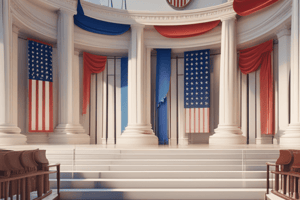Podcast
Questions and Answers
What are the first ten Amendments of the US Constitution collectively known as?
What are the first ten Amendments of the US Constitution collectively known as?
- Founding Principles
- Bill of Rights (correct)
- Decree of Freedoms
- Liberty Declarations
Which Amendment guarantees the right to bear arms in the US Constitution?
Which Amendment guarantees the right to bear arms in the US Constitution?
- First Amendment
- Second Amendment (correct)
- Sixth Amendment
- Fourth Amendment
What key concept in the American political system involves shared power between national and local governments?
What key concept in the American political system involves shared power between national and local governments?
- Totalitarianism
- Dictatorship
- Imperialism
- Federalism (correct)
Which ancient civilization had strong city-states and influenced the concept of federalism in America?
Which ancient civilization had strong city-states and influenced the concept of federalism in America?
Which part of the US Constitution prevents unreasonable searches and seizures?
Which part of the US Constitution prevents unreasonable searches and seizures?
What was adopted by the Constitutional Convention on September 17th, 1787, establishing the basic framework for government in the US?
What was adopted by the Constitutional Convention on September 17th, 1787, establishing the basic framework for government in the US?
Why is amending the U.S. Constitution considered difficult?
Why is amending the U.S. Constitution considered difficult?
What purpose does the amendment process serve according to the text?
What purpose does the amendment process serve according to the text?
Why did the Founding Fathers establish checks and balances in the U.S. Constitution?
Why did the Founding Fathers establish checks and balances in the U.S. Constitution?
What is a key benefit of having distinct roles for each section of government as mentioned in the text?
What is a key benefit of having distinct roles for each section of government as mentioned in the text?
How do the branches of government check and balance each other according to the text?
How do the branches of government check and balance each other according to the text?
Why does the U.S. Constitution establish a complex amendment process?
Why does the U.S. Constitution establish a complex amendment process?
Study Notes
Constitution
The United States Constitution is the fundamental law of the land, establishing the basic framework for government. It was adopted by the Constitutional Convention on September 17th, 1787, with three main sections (Articles) containing various clauses, allowing the states to establish governments within their own territories while also providing common rules and principles for all levels of government. These rules ensure uniformity among different parts of the country and prevent any one state from dominating others.
Bill of Rights
One significant part of the US Constitution is its first ten Amendments known as the Bill of Rights. These rights were added later because people felt it was important to protect individual liberties against overzealous government action. For instance, the Second Amendment guarantees the right to bear arms; the First Amendment covers freedom of speech, press, religion, assembly, and petition; the Fourth Amendment prohibits unreasonable searches and seizures; and so forth.
Federalism
A key feature of the American political system is federalism - shared power between national and local governments. This idea has deep roots dating back to ancient Greece where cities often had strong city-states rather than centralized rule. Under federalism, each level of government does some things better than other levels do, making the whole stronger than separate parts could ever be alone. Each level of government can make decisions independently, thereby ensuring that those most affected by such decisions have a voice in them. This also helps avoid conflicts or imbalances which might otherwise arise if just one body made all decisions.
Amendment Process
Amending the U.S. Constitution is difficult because changes must reflect widespread support across many regions and states. An amendment requires approval from two out of three types of groups - either two thirds vote in favor in both houses of Congress; two thirds of state legislatures approve; or constitutional conventions called for in Article V take place followed by ratification through convention delegates chosen by state legislators. Proposals need to pass in the same form they started before becoming actual laws - this prevents compromises being struck during debate. The hardy amendment process ensures stability by limiting how easily major changes can occur to the nation's most fundamental document.
Checks And Balances
Another important aspect of the Constitution is its provision for checking abuses of power. No single person or branch of government holds absolute authority. Instead, there are several branches of government—executive, judicial, and legislative—each intended to check and balance the actions of another. The Founding Fathers believed that dividing responsibility would limit corruption and abuse, helping lead to good governance. For example, Congress cannot spend money unless the President signs off; Supreme Court Justices serve lifetime appointments to keep them free from politics; Congress gets to set tax rates while Presidents decide what programs will receive funding, etc.
Separation Of Powers
Finally, the US Constitution establishes distinct roles for each section of government, preventing too much power accumulating in one area. Each group exercises certain kinds of power only, avoiding disputes over who may do something specific. Some examples here include the executive exercising military force overseas, courts deciding issues related to criminal justice, and Congress having final say on taxes & spending matters. Because everyone knows exactly where responsibilities lie, confusion and conflict remain minimal.
Studying That Suits You
Use AI to generate personalized quizzes and flashcards to suit your learning preferences.
Description
Learn about the foundation of the US government, the Bill of Rights, Federalism, the Amendment process, Checks and Balances, and the Separation of Powers as outlined in the United States Constitution.




